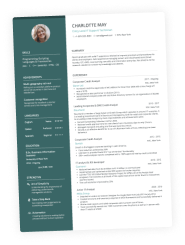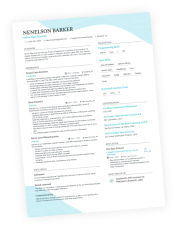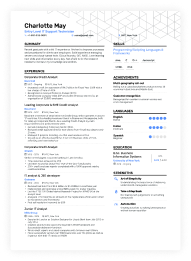Most applicants spend hours deciding how to start a resume—what resume format to use, how to write a resume summary, and which skills to include. But if you're wondering how to end a resume, you're not alone—and you're definitely not wrong.
The truth is, the final section of your resume is more than just a space-filler. It’s your last opportunity to reinforce your value and leave a positive, professional impression on recruiters and applicant tracking systems (ATS).
Whether you're building a resume for a first job, changing careers, or updating your resume after a time away from work, learning how to finish strong matters just as much as how you begin.
Key takeaways
- The end of your resume should reinforce your personal brand and highlight optional but valuable content like certifications, skills, or accomplishments.
- Avoid ending with filler text such as “References available upon request.”
- The closing section varies depending on your resume type—whether you're using a functional resume, a hybrid resume, or a reverse-chronological resume.
- Optional closing sections include: skills, certifications, affiliations, volunteering, languages, and projects.
- ATS-friendly design is just as critical at the bottom as it is at the top. Use an ATS resume scanner to make sure your resume performs.
- Tailor the final section based on the job ad and role type for the best impact.
- Special situations like limited work history or employment gaps require additional care when concluding a resume.
Why the ending of a resume deserves more attention
Recruiters tend to scan resumes in an F- or E-shaped pattern. While the top of your resume draws attention first, the bottom is often where their eyes settle just before they make a decision. That makes the final impression you leave critical to your success.
Ending your resume well can help you:
- Reaffirm your suitability for the role.
- Add job-specific keywords for ATS optimization.
- Show depth through optional sections like volunteering or publications.
- Communicate your professional development.
Think of it as your last pitch—brief, sharp, and full of purpose.
Don’t waste the end of your resume with “References available upon request”—it’s dead space. Instead, treat your final line like a mic drop. End with a quick win: a standout certification, a passion project, or a final achievement that quietly says, “Yeah, I’m the one.” Make them want to scroll back up, not move on.
Writer’s take
Let’s explore exactly what to put at the end of a resume to make it count.
What to put at the end of a resume: 7 strong options
The best closing sections for your resume are those that enhance your candidacy without repeating content from earlier. Choose based on the role, your background, and how much space you have left.
1. Certifications and licenses
Providing certifications is particularly helpful for technical, regulated, or specialized jobs. It’s a clean way to show your qualifications are up-to-date and job-relevant.
2. Skills section (hard, soft, and technical)
If your resume doesn’t already have a dedicated skills section, use the end to include:
- Hard skills (e.g., JavaScript, Excel)
- Technical skills (e.g., CAD design, SQL)
- Soft skills (e.g., leadership, adaptability)
If you list soft skills, seriously consider providing examples to demonstrate them, like below.
Otherwise, just list the skills. Take a look at the following hard/tech skills section.
Match the skills to the job description. Many applicant tracking systems scan for resume keywords, and this section is prime real estate for them.
Applicant tracking systems
When ending your resume, focus on clarity over paranoia—it's time we start busting ATS myths. Today’s systems can handle columns, color, and longer formats just fine. What truly counts is a clean layout and smart keyword use. Let your final section mirror the job description and reinforce your value to both the algorithm and the person reading it.
3. Professional affiliations
If you belong to an industry organization, place it at the bottom. It signals professional engagement and ongoing learning.
4. Languages
Languages should be listed with a proficiency level (e.g., fluent, conversational). This is especially important for roles in international, government, or customer-facing settings.
5. Publications, projects, or portfolios
Use this if you’re in research, writing, tech, or any creative field. Even listing a single portfolio project or technical contribution (with a link, if possible) adds weight to your qualifications.
6. Volunteering and community involvement
Great for new grads, career changers, or those returning to work. Volunteering shows leadership, commitment, and initiative—qualities every employer values.
- •Organized a city-wide book drive that collected and distributed over 2,000 books to underserved schools.
- •Recruited and trained 15 volunteers to run weekend tutoring sessions for children aged 8–14.
- •Developed a digital tracking system for student progress, increasing tutor efficiency by 25%.
- •Led an online campaign that raised $5,400 in six weeks, surpassing the goal by 35%.
- •Created marketing materials and email templates that were later adopted for national use.
7. Awards or honors
Include only those resume awards that are relevant to the job or industry. Don't overcrowd the section—have just the essentials.
PRO TIP
Use bullet points and resume lines for structure, and double-check that your resume layout and design are consistent across all resume sections.
Addressing special circumstances: Endings that work when the journey isn’t linear
Not everyone has a traditional career path—and that’s okay. Whether you’re changing industries, dealing with employment gaps, or have limited work experience, you can still craft a strong closing section on your resume.
Here’s how to tailor your resume to your situation:
If you have limited work experience
Use the final section to highlight:
- Volunteering
- Extracurriculars
- Coursework or certifications
- Transferable skills
Pair this with a compelling resume objective and a strong education section on your resume.
If you’re changing careers
Close with a skills-focused section that shows you have what it takes—even if your past titles don’t match the new role.
Include:
- Transferable skills (e.g., communication, budgeting)
- Industry-specific certifications
- Portfolio projects or case studies
Use a combination or functional resume format to downplay unrelated job titles while emphasizing technical skills and results.
If you have gaps in your work history
Don’t end your resume with a long, unexplained gap.
Instead:
- Add a section for continuing education or certifications.
- Include freelance or contract work.
- Highlight volunteering or personal projects.
Also, consider adding a line in your cover letter to proactively explain the gap.
No matter your background, you can close strong by aligning your final section with what hiring managers value most.
What to avoid at the end of your resume
Let’s talk about what NOT to do when finishing a resume. These mistakes might seem small, but they can derail an otherwise spotless application.
"References available upon request"
Completely unnecessary and outdated. Recruiters assume you’ll provide references if asked.
Personal information
Although not directly connected to the end of your resume, avoid listing age, marital status, or personal photos unless it’s culturally appropriate (e.g., Europass CV).
Repetition
Don’t restate information already covered in your resume summary or work experience. Use the ending for new or supplemental content only.
Sloppy formatting
The last section should be as shiny as the first.
Double-check:
- Spacing
- Alignment
- Resume margins
- Consistent use of resume bullet points
Formatting tips to improve the ending
Good formatting ensures your resume is easy to read and ATS-friendly.
Apply these best practices to the final section:
- Use section headings that match the tone of your resume (e.g., “Certifications” or “Other Achievements”).
- Keep bullet points short and direct.
- Avoid long paragraphs—stick to one idea per line.
- Check for consistency in font size, resume color (if used), and resume icons.
- Use a standard format like PDF or DOC (preferably PDF!).
Also, consider crafting your document with one of our ATS-friendly resume templates or uploading it to our free ATS Resume Scanner.
Final resume review checklist
Use this checklist before hitting “send”
- Is your ending section relevant, concise, and tailored to the job?
- Did you include keywords from the job ad?
- Have you formatted it cleanly and consistently?
- Did you avoid filler phrases like “References available upon request”?
- Have you used an ATS-optimized format?
- Is your resume file name clear and professional? ([naming convention])
- Did you double-check for errors, typos, or formatting glitches?
Bonus tip: If you forgot to attach a resume or submitted the wrong version, follow up quickly and professionally with the hiring manager.
Conclusion: End strong, get noticed
So, what's a good rule to follow before finishing your resume? Make sure the final section adds value and supports your candidacy. It shouldn’t just fill space—it should make a statement.
The best resume endings are customized, concise, and strategic. They align with your story, highlight relevant skills, and make your application stand out in a competitive job market.
Whether you're creating a resume from scratch or simply updating your latest version, knowing how to end a resume is a game-changing detail.
Looking to take your resume from “good” to unforgettable? Try our Enhancv Resume Builder to access smart layouts, tailored content suggestions, and expert-approved templates—designed to help you close strong!
Make one that's truly you.



